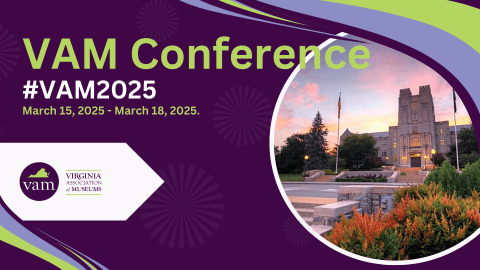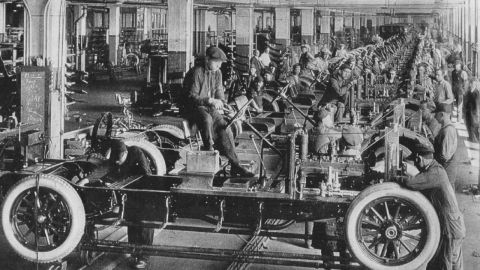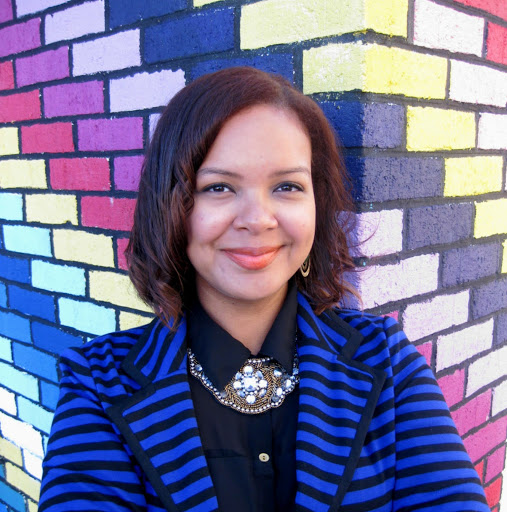
Kayleigh Bryant-Greenwell is an education specialist with the Smithsonian Institution’s National Museum of African American History and Culture. This essay is adapted from her presentation “Activating Social Justice in the Museum: A Public Programs Approach” at the 2017 Association for African American Museums (AAAM) conference.
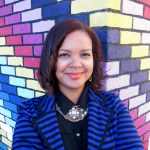
In the effort to be actively responsive social and cultural institutions one of our biggest challenges today is grappling with the role of social justice in museums. As our national discourse grows increasingly polarizing and often hurtful, it is difficult to determine welcoming ways to navigate social issues in a museum setting. Our museum communities–increasingly populated by activists and thought leaders–are eager for a place in the conversation in our spaces, and often through social media are already engaging with our institutions in this way. Open dialogue is a force on digital platforms, but implementing such conversations in our physical spaces can be intimidating. But that is the heart of the Smithsonian Institution’s National Museum of African American History and Culture’s new public program series: A Seat at the Table.
A Seat at the Table provides a platform for audiences to consider challenging questions about race, identity, equity, and progress.
A Seat at the Table is a borrowed phrase from Langston Hughes’ iconic poem, I, Too, am America. Words from this poem are carved on the walls of the museum’s history galleries.
At A Seat at the Table audiences are empowered to take their rightful seat at the table over a family-style meal, following critical conversations for social justice, featuring guest speakers whose work and commentary seeks progress for all people of color. Audiences take the lead in sharing critical thinking, problem-solving, and strategies towards a more equitable society.
The program acts as a social justice conversation exploring issues of contemporary importance linked to systemic racism, social inequity, and the black community. This program amplifies an important pillar of the museum’s mission to explore:
- the American experience through the African American lens
- what it means to be an American
- and share how American values such as resilience, optimism, and agency are reflected in the African American community’s past, present, and future
In designing the program, we aim to play a key role in personal and societal betterment, to jumpstart critical thinking skills and creativity through curated activities intended for exchanging ideas and strategizing for a better world. We frame each program to begin with a centering performance–poetry, spoken word, rap, etc.–followed by an engaging conversation between social justice experts in the field.
Audience Participation
We embrace the idea of sharing the authority of content creation with our audiences by encouraging our attendees to define our shared concepts, such as, “What is equity?”
We stimulate an exchange of ideas about how to create inclusion within communities through challenge questions provided to each table. In the framework of A Seat at the Table following the conversation between the expert panel, audiences take the lead in a dynamic dialogue about the same topic. We design the tables organized in a cozy fashion in the center of Heritage Hall, in order to encourage strangers to sit together for engaging and meaningful dialogue.
A Seat at the Table with Immigrants of Color
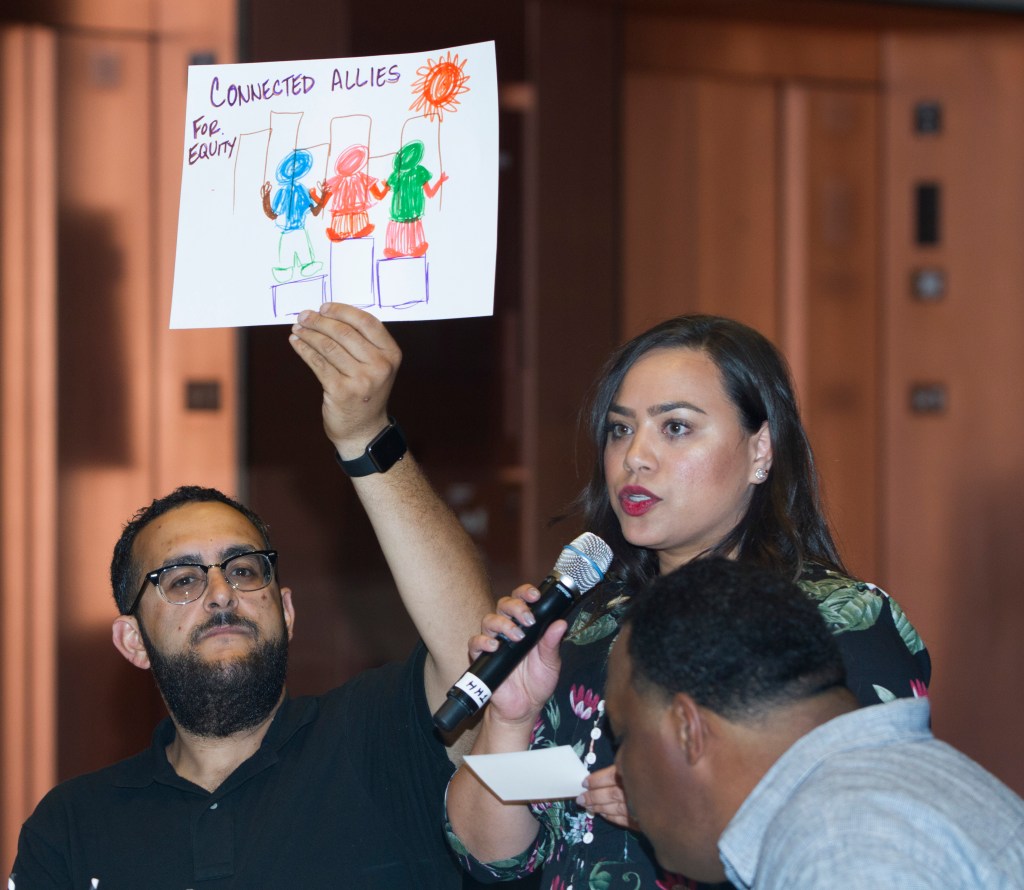
The inaugural program held on May 19, 2017, welcomed a sold-out crowd of 200 guests interested in exploring meaningful dialogue considering strategies for strengthening a unified force for equity within black and immigrant communities and beyond. Conversations centered on inclusivity, diversity, and unity within all facets of the community, as an important pillar of creating a more equitable society.
Historian and internationally-acclaimed rap artist, Jason Nichols, opened the evening performing a new work, specifically commissioned for this program, which described the trauma of racial discrimination experienced by immigrants and American-born people of color alike, and his courageous anticipation of a better tomorrow.
Speakers: Angela Glover Blackwell, Founder and CEO, PolicyLink; Namira Islam, executive director of MuslimARC; and Trina Jackson, moderator, of the Network of Immigrant and African Americans in Solidarity kicked off the evening with a lively exchange of experiences and insights considering issues affecting both immigrant and black communities.
Throughout a hopeful and passionate exchange speakers considered the question: In a country divided, how do we create equity for all people? Themes from the dynamic discussion were; historical memory, dignity, civil protest, multiculturalism, and diversity.
We prompted table groups to explore the question: “What does a seat at the table mean to you?”
Audiences courageously shared emotional and personal stories with their tablemates, discussing personal experiences of discrimination, and affirming that oppression of one group is oppression for all.
Audiences shared a desire towards creating more inclusivity within their own communities. Empathy was a common theme emerging across the 20 tables.
A Seat at the Table with LGBTQ Friends in Faith
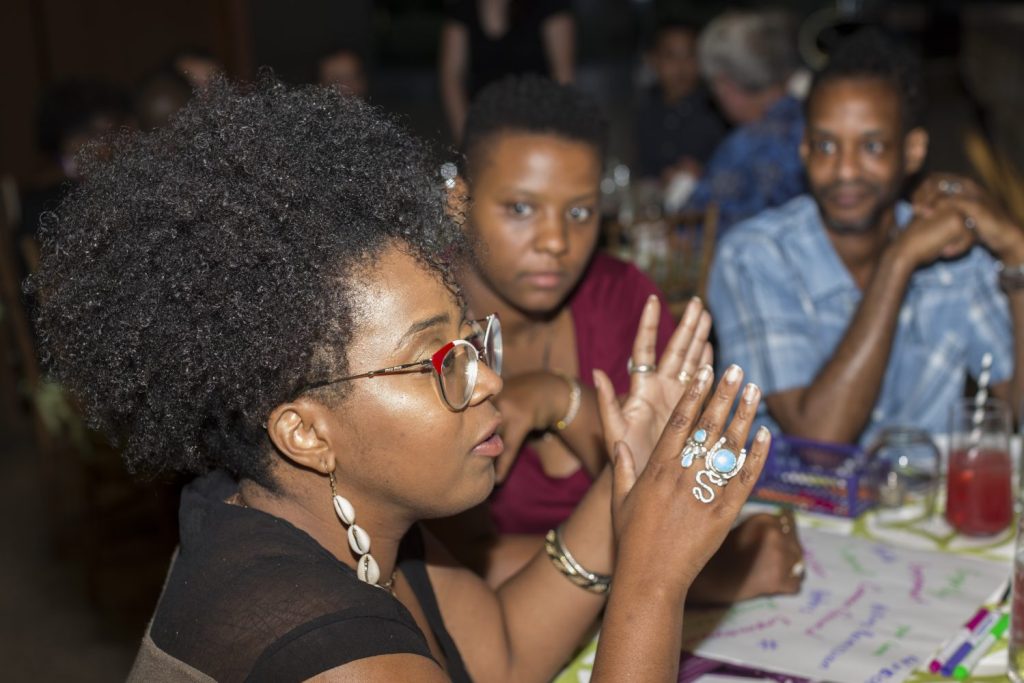
The second program held on June 11, 2017, again welcomed a sold-out crowd of 200 guests interested in exploring meaningful dialogue considering LGBTQ and faith-based concerns within the black community and beyond.
International-sensation and South African spoken-word poet, Lee Mokobe, a proud trans man, opened the evening performing three new works, specifically commissioned for this program, which described the trauma of trans-phobia discrimination he has experienced and his unwavering hope for a freer, more equitable future for all people.
Speakers: Rev. Dr. Yvette A. Flunder, Founder and Senior Pastor, City of Refuge United Church of Christ; Yoruba Richen, filmmaker, and activist; and Earl Fowlkes, moderator, and CEO of the Center for Black Equity, Inc. considered the question: How can we build bridges within LGBTQ and faith communities?
Bishop Flunder, an evangelizing preacher of warmth and joy, brought down the house with her powerful words preaching the gospel of love, unity, diversity, and equity. Themes from that discussion were; respect, community-building, perseverance, integrity, and humanity.
We prompted table groups to explore the question, “How can contentious groups put aside what divides them in favor of what can unite them as allies?”
Audiences ranged across the spectrum of LGBTQ and faith identities, as well as being diverse across age and race demographics.
Again, audiences bravely shared emotional and personal stories with their tablemates. At one table a group identified themselves as people of faith, unsure of how to reconcile with LGBTQ identities. When asked why they wanted to attend the program, they answered that they were curious to learn more about people they didn’t really understand and that they want to be open to being more inclusive in their own community.
Similarly at another table a group of young men identified as openly gay, unconvinced that the faith community was a place they wanted to be, but were curious to hear from the other side.
In addition to discussion questions, we further challenged audiences to consider strategies for advancing social justice and positive change within communities of color and beyond, by creating a word-cloud on a poster which summarizes their conversations. We invited audiences to share their ideas on social media with our hashtag: #SeatAtOurTable
Transformational Experiences
In the final segment of each program, we provided a microphone and instructed the tables to designate one speaker to share what they created for their poster.
Throughout a lively stand-and-share session audiences warmly cheer each other for boldly proclaiming affirmations of diversity and inclusion.
At A Seat at the Table with LGBTQ Friends in Faith, audiences courageously shared concerns of equity and gaps within the community and thoughtfully considered ways to address issues of fairness throughout society.
A chorus of “Amens!” and “Preach!” were exclaimed throughout Heritage Hall, culminating in a spontaneous group sing of “Lift Every Voice.”
By exchanging deeply personal ideas and experiences total strangers quickly became friends as the local community of diverse socially-concerned individuals became more connected with one another and with the museum.
These experiences were transformational in three main ways.
First, audiences opinions or assumptions were transformed through dialogue with people they may not have otherwise ever conversed.
Second, through sharing deeply personal stories and experiences, audiences emoted in passionate ways–there were tears of joy, sadness, relief, and liberation shed as the program touched guests in profound ways.
Lastly, by opening the dialogue for audiences to participate on equal terms, we transformed the ordinary museum experience into the extraordinary.
Outcomes
Through both A Seat at the Table programs we hosted this year, we found that the Museum provided:
- a community of activists and thought-leaders the only local forum to connect with diverse groups who previously existed independently of each other
- a welcoming safe space for an engaged museum community to activate critical thinking towards creating a better future for all communities of people of color
- an inviting opportunity to amplify the creative agency of museum audiences and magnify the role of the museum as an active partner in the community
We created a space that warmly invited open dialogue about challenging issues. The participatory format of A Seat at the Table actually requires open discussion by audiences, without critical conversations the program wouldn’t work. To our delight and relief, our audiences readily responded to our invitation to share ideas, insights, and experiences with us. But we were prepared with facilitators assigned to each table in case conflict or friction arose between guests. Honoring our unique invitation to share personal feelings about equity, audiences rose to the occasion of respectful and kind exchange. Differences of opinion were honored and the dignity of all participants thrived.
When my colleagues and I presented these remarks at AAAM 2017 and opened the session for questions, one of our peers in the audience bravely asked, “How do you keep these programs from just preaching to the choir? How do you ensure that the people who need to hear this are attending?”
It’s a tough question, without an easy answer. My personal answer is this: A Seat at the Table is thoughtfully constructed to facilitate dialogue and healing for a traumatized community, wracked by violence and discrimination against their humanity. Just as the dinner table is a communal space where we gather to share a meal, ideas and bits of ourselves, A Seat at the Table must be a welcoming environment where minds meet, hearts unite and spirits take flight. Museums provide not only a reflection of their communities but also a vision of their apotheosis—the best of what we can be.
About the Author
Kayleigh produces participatory public programs including A Seat at the Table and art + justice. She is also a contributor to the Museums As Sites for Social Action initiative hosted by Minneapolis Institute of Art. Before coming to NMAAHC, she contributed to the launch of the Women, Arts, and Social Change initiative at the National Museum of Women in the Arts, as the public programs coordinator. There she advanced feminism advocacy and brokered diverse and creative collaborations between the museum and local activist and arts leaders. She earned her Bachelor of Arts in Art History from the University of Maryland, College Park and her Master of Arts in Museum Studies from The George Washington University in Washington, DC. Tweet @KayleighBinDC

